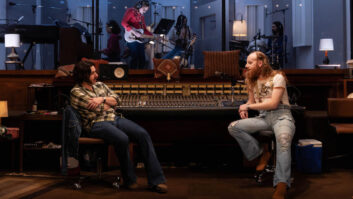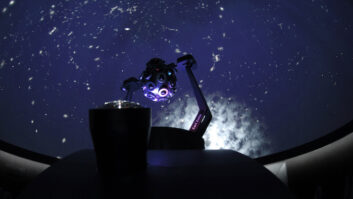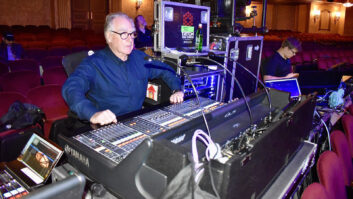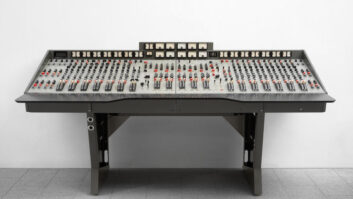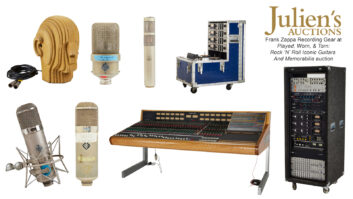Coming from a recording background, Tim O’Heir has been nominated for a Best Sound Design of a Musical Tony Award for his work on Hedwig and the Angry Inch. New York, NY—Revived from its off-Broadway and cult classic film counterparts, Broadway’s Hedwig and the Angry Inch follows an East German transgender rockstar’s struggle to fame after her bandmate and ex-lover steals her songs. Starring Neil Patrick Harris of How I Met Your Mother fame, the show has been nominated for eight Tony Awards, including Best Revival of a Musical and a Best Sound Design nomination for Tim O’Heir.

The story follows Hedwig, who after falling in love with a U.S. soldier, decides to have a sex change and move with him to the United States. However, the surgery doesn’t heal properly for now-female Hedwig. Upon her husband leaving her after their move to Junction City, KS, Hedwig forms a rock band called The Angry Inch and collaborates with her next boyfriend, Tommy Gnosis, who steals her songs and is soon touring large stadiums while Hedwig and her band continue to grace coffee shops and cafes.
With a soundtrack reminiscent of the 1970s glam rock era, the sound system design needed to mimic the setting of a rock club or concert hall, leaving O’Heir, the show’s sound designer, with the challenge of creating a high-energy rock show in the historic Belasco Theatre. Production Resource Group (PRG) supplied the majority of the equipment for the show.
O’Heir came to sound design from the world of record production; besides working with Hedwig composer Stephen Trask in 1999 to record the movie version’s score, he also tapped his experience working in the studio with artists like The All- American Rejects, The Flaming Lips and Say Anything for the musical.
“My job is to translate a rock and roll show to a Broadway audience,” O’Heir said. “It has to be a fullblown, rock concert sound, and my job is to create that in a theater built in 1907, while also figuring out how to keep the audience from running with their fingers in their ears.”
“This production is very fast and furious though,” O’Heir added. “It’s different from a record production. With records, you can go over things. You have that luxury because you’re making something that can last forever. When it’s live theater, it sounds different.”
With the help of sound designer Kai Harada, O’Heir was able to create a rock club atmosphere, bringing in acoustic panels to help with the echoes coming from the balcony sections of the theater. Facing a limited budget, however, reducing the echo relies heavily on a sold-out audience.
The venue also went through a recent renovation, creating another challenge for O’Heir when it came to speaker placement. “All the detail in the theater is plaster, done by Italian artists,” said O’Heir. “Therefore, anything we did, any hole we punched in the wall, has to be repaired. Going into this old theater, we had to be very wary. The walls weren’t built to hang these speakers.”
Even with some anchoring spots added over the years, O’Heir and his team still had to be aware of preserving the building as they hung a variety of loudspeakers from Meyer Sound, including an 11-box M’elodie cluster and 16 M2Ds covering the balcony, mezzanine and far stalls, along with a variety of UPQ-1Ps for inner stalls; UPJ-1Ps for downfill and foldback; two UPJuniors; UP-4XPs for front- and box fills; 600-HPs as truss subs; and a USW-1P sub— along with d&b audiotechnik models.
The band plays a central role in the show, and to stick to the image of a rock and roll band, O’Heir said he wanted to use a live drum set without a plexiglass cover. “I worked with the composer to decide if we wanted to use electronic drums to help control the sound, but we decided it just wouldn’t sound right. Hedwig is a rock and roller, and she’s not going to have plexiglass over her drums,” he said.
All of the performers are equipped with Ultimate Ears in-ear monitors, with a Shure wireless RF system. “With all the drums on stage, the in-ears help cancel everything out,” O’Heir explained.
The sound crew did encounter one issue with the wireless system, O’Heir said, during certain scenes when Neil Patrick Harris was wearing a customized crystal costume. “The crystals were embedded in lead, and lead cancels out transmissions and reception,” O’Heir said. “We had to make a few costume adjustments and remove some of the beading. It was just something you wouldn’t think would cause a sound issue.”
The show is mixed on a selection of Midas consoles, with a Midas Pro9 at front-of-house, and a Midas Pro2 for monitors. O’Heir said he also chose to use some Waves plug-ins for the show. He said that while Midas isn’t always a typical choice for a theater performance, it’s a great rock and roll board: “I wouldn’t necessarily choose that desk for other shows, but I’m glad I chose it for this—it sounds fantastic.��
Because of the rock and roll nature of the show, performers are mainly singing into Sennheiser 935 handheld microphones. “Our mics are both wired and wireless,” said O’Heir. “We had to teach some mic technique, because we can always have a really direct sound as long as the singer is singing into the microphone.”
“This show is really unique,” O’Heir said. “The director, Michael Mayer, is known for his rock and roll productions. There’s not going to be another Broadway show like this—it’s a full-fledged emotional experience.”
Hedwig and the Angry Inch
www.hedwigbroadway.com

